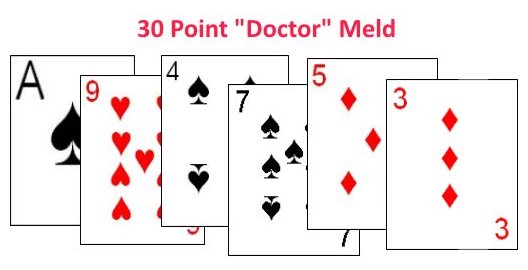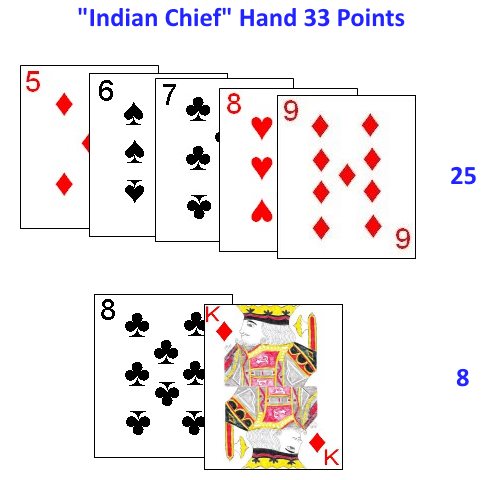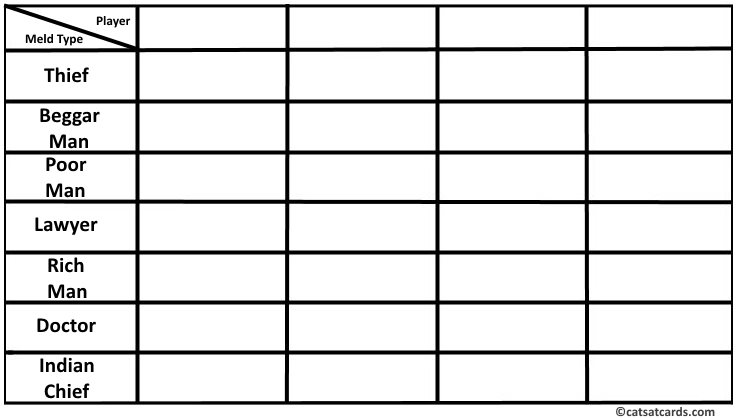- Thief:
The thief is a meld consisting of exactly one card of choice from the player's hand. The player earns a score for this meld equal to the point value of the card so played. The thief card also has a special capability during the hand; After all melds have been scored for that round, the player who played the thief card can then take (steal) any other card from another meld into his own hand. If multiple players play a thief meld, the order in which the player may take cards is from the lowest card played to the highest. If two or more players play thief cards of the same rank, they must agree amongst themselves which card each player will take. If they are unable to agree, none of the players may steal a card.
- Beggar Man:
This meld consists of exactly two cards of the players choice from his hand. For each card played by other players of the same rank as a card from this meld, the player who makes this meld scores 2 points. This applies to both cards which are part of this meld. If the player melds two cards of the exact same rank, however, he only scores once for each card of the exact same rank on the table.
- Poor Man:
This meld consists of three cards of the players choice from his hand. However, only cards in the suit of Spades can be scored in the meld. The score earned is thus the total sum of card ranks of cards in the suit of Spades melded by the player.
- Lawyer:
This meld consists of four cards from the players hand. In order to earn points for the meld, the ranks of the four cards in the meld must total to exactly 25. If they do so, the player scores 25 points for the meld, otherwise he scores 0 for the meld.
- Rich Man:
This melds consists of any five cards from the player's current hand. The points for this meld are actually subtracted from the players score. Thus, the score for this meld should be recorded on the scoresheet as a negative value, as the sum total of the five cards in the meld will be subtracted from his own score when scores are totaled at the end of the game.

- Doctor:
The Doctor meld consists of exactly six cards of choice from the player's hand. In order to score any points for the meld, the meld must fulfill very stringent requirements; It must contain at least one Ace, it must contain at least one card in the suit of Hearts, and no two cards in the meld may be of the same rank. If the meld does fulfill this criteria, it scores 10 points per card in the suit which has the most cards represented in the meld.
- Indian Chief:
The Indian Chief consists of seven cards from the player's hand. These seven cards are further split into two different melds, a two card meld and a 5 card meld, each of which is scored independently.
- Two Card Hand - The score for the two card portion of the Indian Chief hand is calculated in the following manner; The sum of the two cards are added together and only the ones digit of the total is counted. For example, if this portion of the hand consisted of a 9 and a King (for a total of 19), the player would score 9.
- Five Card Hand - The five card portion of the hand is scored based on the best combination that can be made with those cards from the following chart:
| Name | Combination | Scoring Value |
|---|
| Straight Flush | Five cards in sequence, all of the same suit. | 45 |
| Four of a Kind | Four cards all of the exact same suit. The fifth card can be any other card. | 40 |
| Full House | Three cards of the exact same rank, and two other cards both of the same rank. | 35 |
| Flush | Five cards all of the same suit, but not all in sequential order | 30 |
| Straight | Five cards in sequence, not all of the same suit. | 25 |
| Three of a Kind | Three cards of the exact same rank. The other two cards can be anything. | 20 |
| Two Pairs | Two cards of the same ranks, and two other cards of identical rank. The odd card can be anything. | 15 |
| One Pair | Two cards of the exact same rank. The other three cards of the hand may be anything. | 10 |
| Mixed Cards | A five card combination that does not fulfill
any of the other combinations. | 5 |
|
|
 |
The scores for both portions of the hand are then summed together and recorded on the score sheet for this category. The relative ranking of the cards, particularly for the purposes of straights, is as follows (from high to low); Ace, King, Queen, Jack, 10, 9, 8, 7, 6, 5, 4, 3, 2.
After each hand, the dealer then replenishes each player's hand to eight cards. If a player played the thief and elected to steal a card from the table, he will not receive any replacement cards during this hand since he will already have eight cards in hand. After each player has received his replacement cards, the melded cards from the table are then all gathered together and shuffled with the remainder of the stock to create a new stock pile.
After this procedure the players then examine their hands and select the appropriate cards and number of cards for the next meld type they intend to play for the next hand.
The game continues for exactly seven rounds or hands. After the seven rounds have been played, each player should have recorded a score in each meld category. The scores should be totaled, and the player with the highest score is declared the winner of the game.
Variations and Optional Rules
Double Deck Indian Chief: Indian Chief is often played with two standard 52 card decks shuffled together. This is usually done to increase the number of players
which can participate in the game, up to a maximum of eight. Although not strictly necessary, it is best if the two decks used have the same back design.
The only difference between this game and the standard game as described above, is that with two decks, during the Indian Chief round, the potential exists for a player to get five cards of the exact same rank (five of a Kind). This hand scores 50 points if played as part of the Indian Chief meld. In all other aspects Double Deck Indian Chief is played the same as the version described above.
Copyright © 2015 CatsAtCards.com. All rights reserved.
|


 ScoreSheet: As mentioned above, this game requires a special scoresheet to assist in recording the scores for the player. This scoresheet can easily be created on lined paper, by creating one horizontal row for each of the 7 meld scoring categories and one vertical column for
labeling the score types and one for each participant in the game. We have provided a printable, sample such scoresheet. Click this link for a printable version of a score-sheet designed to be used for this game.
ScoreSheet: As mentioned above, this game requires a special scoresheet to assist in recording the scores for the player. This scoresheet can easily be created on lined paper, by creating one horizontal row for each of the 7 meld scoring categories and one vertical column for
labeling the score types and one for each participant in the game. We have provided a printable, sample such scoresheet. Click this link for a printable version of a score-sheet designed to be used for this game.